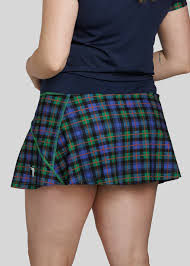Tartans
THERE are a number of Murray tartans, but only four are generally available today: Murray of Atholl (ancient); Murray of Atholl (modern), Murray of Tullibardine; and Murray of Elibank. The ancient tartans have the same warp and weft as the modern versions, but the colours appear less vibrant, or more faded and washed out. This is an attempt by the weavers to imitate use of colors thought to have been achieved by using ancient plant dyes.
James Logan, writer of the two-volumed ‘The Scottish Gael’, spent many years researching the setts of tartans, collecting antiquities and untangling tales. His work was published in 1831 and is regarded as a major reference point. Logan suggested that the Murray of Atholl tartan derived from the Black Watch and that Lord George Murray, who commanded the regiment, introduced the red lines. William & Andrew Smith in their 1850 publication say: "The genuineness of our specimen . . is confirmed by the description which Colonel Stewart gives of the philibeg of the 42nd, when that regiment was first embodied. He says: 'Lord George Murray gave the Atholl Tartan for the philibeg: the difference was only a stripe of scarlet to distinguish it from the belted plaid'."
A reference in a Harris Tweed article reads: "In 1846 the Countess commissioned the sisters to weave lengths of Tweed in the Murray family tartan to be made up into tweed jackets for the gamekeepers and ghyllies on her estate."
Murray of Elibank tartan
THE MURRAY OF ELIBANK tartan dates to a 1930 pattern. Kinloch Anderson was delighted to supply the kilt outfits for Jamie Murray's wedding to Alejandra Gutierrez. Tennis aces Jamie and Andy Murray wore exclusive kilts made in the Murray of Elibank tartan. Elibank is a title in the peerage of Scotland conferred in 1643 on Sir Patrick Murray, descended from the Murrays of Blackbarony in Peebles-shire, who claim an ancient descent independent of all other families of the name, and whose great ancestor is supposed to have been Johan de Morreff, in the Ragman Roll, one of those Scots barons who swore allegiance to Edward I in 1296. William de Moray, conjectured to be his son, was one of the prisoners taken at the battle of Durham with King David II on 17th October 1346. John de Moravia or Murray, supposed to be this William’s son, a man of distinguished rank and figure in the reigns of Kings Robert II and Robert III, is particularly mentioned in a charter of date 14th March 1409-10, as proprietor of the lands of Halton-Murray or Blackbarony. From him descended Alastair Erskine-Murray, the 13th Lord Elibank, who founded the Murray Clan Society on 17th January 1962 in Edinburgh.
Tartan in the 21st century

WHEN IT COMES TO WOMENSWEAR, tartan has skilfully found its way from the tartan sash to every skirt style imaginable: kilted, mini, maxi, box pleated, high waisted, bias cut, and so many more. Fast-forward to today and tartan skirts are at the height of fashion and can be found in all the major cities of Europe, as well as in America and the Far East. In the 21st-century, as films and TV programmes have increased, we have seen a demand for kilts and Scottish clothing, which is fashionable. One thing without a doubt is sure, the intrinsic heritage value of tartan – a sense of belonging with roots so deep and so rich that it remains timeless throughout the generations that continue to proudly wear and showcase their ancestry. First recognised in Nova Scotia (Canada) in 1987, Tartan Day is a chance for people around the world, from Australia and New Zealand to Argentina, to celebrate their connections to Scotland. In some locations, including the United States (US) and Canada, Tartan Day is marked on 6th April with the biggest global celebration held in New York with a week of events culminating in the Tartan Day Parade. This date coincides with the signing of the Declaration of Arbroath – Scotland's own Declaration of Independence – which took place in 1320. In Australia and New Zealand, Scottish heritage is marked with an International Tartan Day on 1st July, celebrating the repeal of an Act of Parliament that banned the wearing of tartan. The following link is a recommended guide to Scottish tartans: https://www.lulus.com/blog/fashion/a-guide-to-scottish-tartans/











